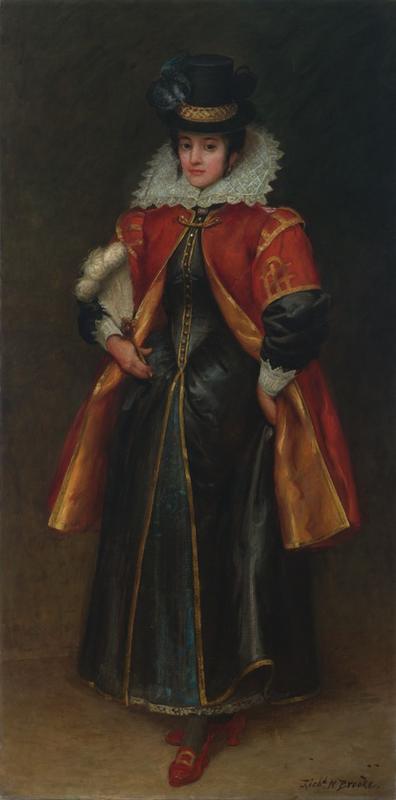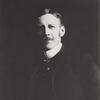More about Pocahontas

Contributor
According to his diary, carefully maintained and republished by Walt H. Sirene, Richard Norris Brooke began his ambitious and glowing portrait, Pocahontas, on Rue Lamartine in Paris at the age of forty-two.
For some reason, when Brooke tried to make progress on this work, he couldn't seem to get a groove going. Something didn't click. It didn't help that his model, Mataoka, who had concealed her name according to Powhatan tradition, until receiving the name "Rebecca" from English colonists, had lived over a quarter millennium earlier, and wasn't available to pose for Brooke in person. To complicate matters even further, Brooke only had one image to work with, a picture given to him by a "Mrs. Herbert Jones" of Sculthorpe Rectory in Norfolk, England. In her palatial estate, which you can now reserve as a year-round holiday retreat for "up to ten guests, " or, as of recently, buy for the bargain price of £2,650,000, Mrs. Jones was active in maintaining historical records of Mataoka, lending her expertise to various specialists. Jones gave Brooke a reproduction of an engraving by Simon de Passe of the 21-year-old woman, inscribed with the name Mataoka, which is the only authentic image of her from life.
In the last decade, Mataoka scholarship has been rumbling with debate and uncertainty due to the appearance in print of The True Story of Pocahontas: The Other Side of History, the oral history of two Mattaponi authors, the late Dr. Linwood "Little Bear" Custalow, the first native to graduate from med school in Virginia, and Angela L. Daniel, "Silver Star." The vast majority of professional Pocahontas-ologists (including Disney, of course) haven't commented on the book, which offers a great number of details unavailable in any other source , many of them horribly tragic. A few historians endorse the book, and a few others want to blot it from history. The Mattaponi people number around one thousand members and belong to one of the six Algonquian-speaking nations inherited by the Powhatan chiefdom of Wahunseneca, Mataoka's father. Custalow and Daniel write that Pocahontas was actually Mataoka's mother's name.
None of this information was available to Brooke, of course. John Smith's stories, probably inaccurate, had lots of influence then, and still do now. Staring at the de Passe engraving, Brooke started to lose his mojo. "The Court Costume on an Indian Type was not pleasing and made it exceedingly difficult," he sighed. Two years went by, and still no finished product. He didn't finish this work until he came back Stateside, where it ended up in the now-defunct Confederate Memorial Institute. This work was later donated to the Virginia Museum of Fine Arts by John Barton Payne, Secretary of the Interior during the Presidential Administration of Woodrow Wilson. Most of us are unaware that Brooke's decision to portray Mataoka as a non-"Indian type" has made this work a lot more abstract than it might seem. I haven't been able to find out who this beautiful European woman is, but it's certainly not Mataoka. Is that you, Mrs. Jones?
Sources
- Custalow, Linwood "Little Bear," and Angela L. Daniel, "Silver Star." True Story of Pocahontas: The Other Side of History. Golden, CO: Fulcrum Publishing, 2016.
- "Pocahontas." VMFA, https://www.vmfa.museum/piction/6027262-7899924/.
- Rountree, Helen C. Pocahontas, Powhatan, Opechancanough: Three Indian Lives Changed by Jamestown. Charlottesville: University of Virginia Press, 2005.
- Sirene, Walt H. Richard Norris Brooke - Artist - Record of Work: “Serving to some Extent as a History of my Professional Life And As a means of Tracing Pictures and Studies Painted and Disposed of Especially Since my departure for Paris in 1878”. Warrento
- Sirene, Walt H. Richard Norris Brooke, Celebrated Artist: He pictured Warrenton VA area Scenes and People. Warrenton, VA: Self-Published, 2019.
- Smith, John. Works, 1608-1631, Volume 1. Westminster: Archibald Constable, 1895.
- "The Old Rectory." Big Cottages, https://big-cottages.com/properties/united-kingdom/england/norfolk/nort….











